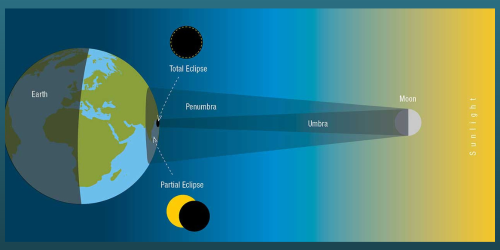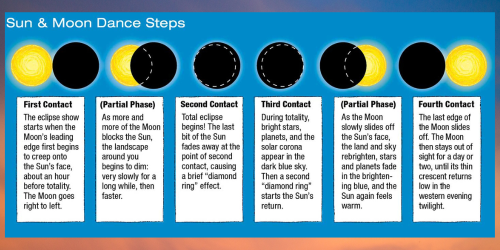As curious human beings, we are always fascinated by the miracles of nature and the solar eclipse is no different. It piques everyone’s intellectual interest to understand a phenomenon that is seemingly deeper than what meets the eye. Let us use this opportunity to learn a little more about the total solar eclipse in Texas this month and what to expect.
The Science Behind a Solar Eclipse
A solar eclipse occurs when the position of the Sun, Moon, and Earth are perfectly aligned such that the Moon’s shadow on the Earth either completely or partially blocks the Sun’s light. This phenomenon occurs occasionally because the Moon does not orbit in the same plane as the Sun or the Earth. The Moon’s orbit around the Earth is tilted when compared to the Earth’s orbit around the Sun.
As the name suggests, a total eclipse is one where the Moon completely covers the Sun on parts of the Earth. In contrast, in a partial eclipse, the Moon covers only a small portion of the Sun’s surface. People who reside in geographical areas that fall within the dark part of the Moon’s shadow (i.e., the umbra), will experience a total eclipse. Those residing in regions that fall in the light part (i.e., the penumbra), will see experience a partial eclipse.

NASA suggests that during a total solar eclipse, observers will be able to see multiple unique features as the eclipse progresses from a partial to a total eclipse. A partial solar eclipse is more common than a total eclipse.

Marvel at the Cosmic Spectacle
A solar eclipse is an awe-inspiring cosmic exhibition where the huge and bright sun is overshadowed by the much smaller moon that depends upon the sun for its light. Such an awe-inspiring event increases our reverence for creation and the Creator. It makes us remember the inconceivable power of the Divine Supreme Lord that manifested infinite universes with magnificent phenomena. It makes us feel humble about the insignificance of us tiny souls who depend upon the Creator for our existence.
During a total solar eclipse, after experiencing the visual wonder, take a few seconds to pause and listen to the sounds of nature. Do you hear the breeze? Do you hear the birds chirping? Do you hear the beetles and bugs? What is different than what was visible before the solar eclipse started?
Basic Facts: Solar Eclipse in Texas
Some information regarding the date, day, and time of the solar eclipse as provided by the priests at the Radha Krishna Temple of Dallas (Allen) are as stated below:
- Date: April 8, 2024 (Monday)
- Start Time in Texas: 12:16 PM CDT
- Total Eclipse Start Time: 01:35 PM CDT
- Maximum Eclipse Time: 01:36 PM CDT
- Total Eclipse End Time: 01:37 PM CDT
- Eclipse End Time: 02:57 PM CDT
- Total Eclipse Duration: 02 Minutes 39 Secs
- Total and Partial Eclipse Duration: 02 Hours 40 Minutes 52 Seconds
View the Solar Eclipse in Texas
Safety Precautions: Do’s and Don’ts for the Solar Eclipse
The Radha Krishna Temple and JKYog would like its devotees and community members to be safe during the solar eclipse by following some very simple measures.
- When watching a solar eclipse, people must use safe solar viewing glasses, also known as the eclipse glasses. We should not substitute regular sunglasses no matter how dark they may be because they are not safe.
- Supervise your children and make sure that they wear safe solar viewers.
- Make sure to check safety procedures from NASA or similar agencies before recording or viewing the solar eclipse with a camera, camcorder, telescope, binoculars, or any other optical device.
- If spending a great deal of time outdoors while waiting to view the solar eclipse, be sure to stay properly hydrated. Protect your skin with proper clothing and sunscreen, especially in higher altitudes.
- Beware of false superstitions without harboring negative thoughts when coincidental events occur.
FAQs
- How dark does it get during a solar eclipse?
If you are in a location of a total solar eclipse (i.e., the moon covers the sun completely), the sky will be dark like it is during dawn or dusk. If you are in a zone with a partial solar eclipse, the sky will appear relatively darker than before the eclipse but not entirely.
- The sun is so much bigger than the moon. How does it block the sun?
This is a perfect example of optical illusion! During a total solar eclipse, it is coincidental that the Sun and Moon appear to be about the same size as viewed from Earth. That is because the Sun, which is about 400 times bigger than the Moon, is about 400 times farther away from the Earth. Thus, they both appear about the same size in the sky in the same way as a person standing in front of a glass window may appear to be similar in size to a huge mountain in the background.
- Why do solar eclipses not occur at every New Moon?
According to Astronomy, the Moon’s orbit is tilted 5° compared to Earth’s orbit around the Sun. Astronomers call the two intersections of these paths nodes. Eclipses only occur when the Sun lies at one node and the Moon is at the same node. https://www.astronomy.com/observing/25-facts-you-should-know-about-the-total-solar-eclipse-on-april-8-2024/
- Will the daytime temperature drop during a total solar eclipse?
NASA scientists suggest that the daytime temperature may drop about 10 degrees Fahrenheit (or 5 degrees Celsius) depending on the humidity and cloud cover at a given geographical location.
- Is it the bright light of the Sun that makes it dangerous for the eyes when viewing a solar eclipse?
While specially designed eclipse glasses may safely block the intense sunlight that damages the retina, it is the infrared heat from the Sun that is dangerous because it overheats the tissues and fluids in the eyes.
Click this NASA link to watch the solar eclipse live from the safety of your device.


